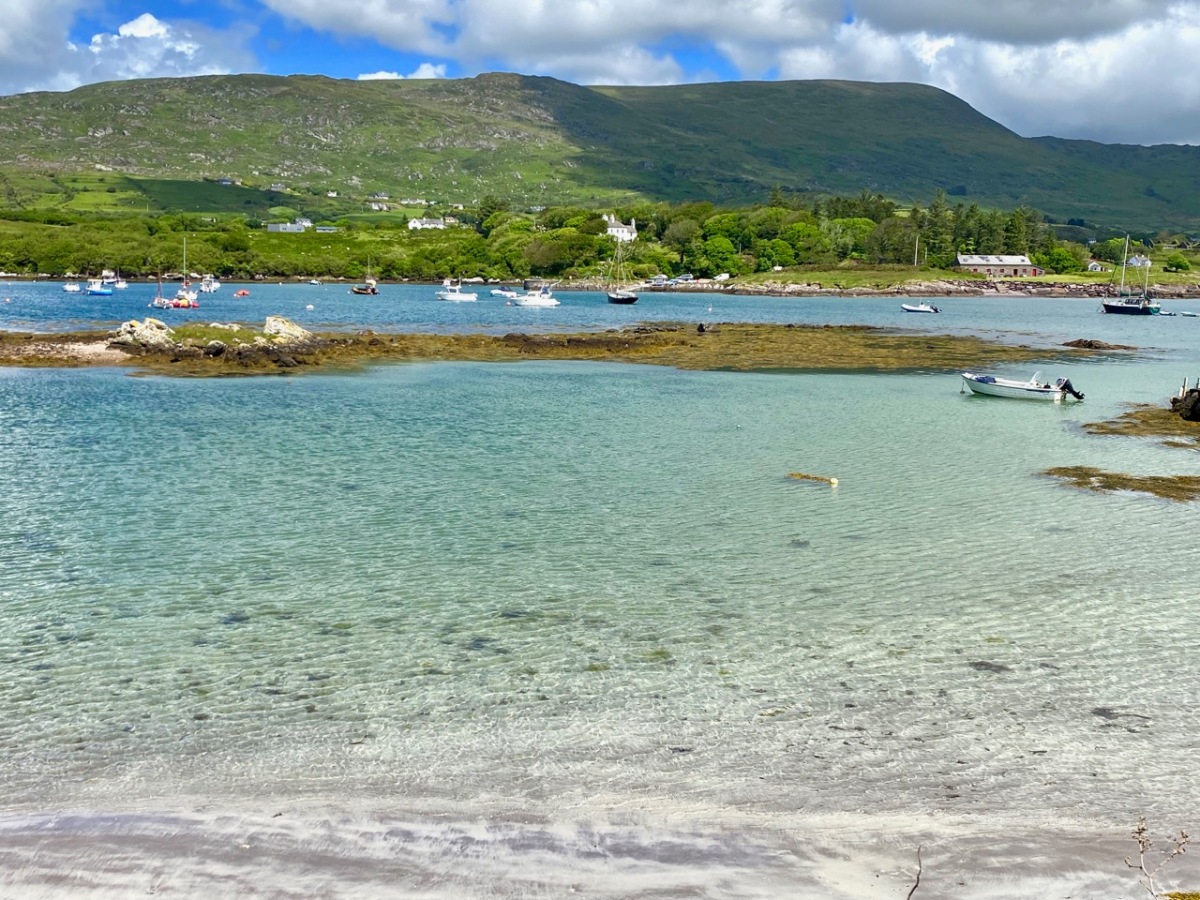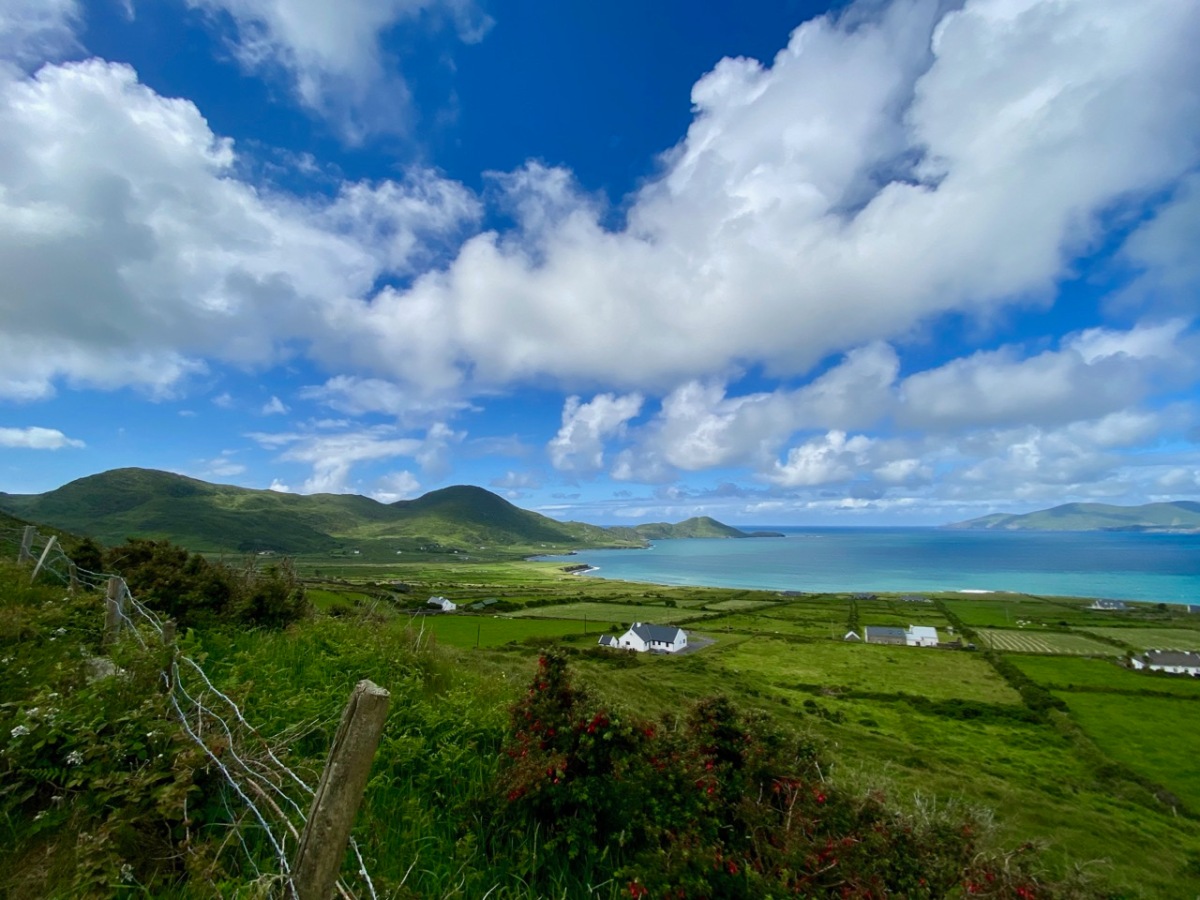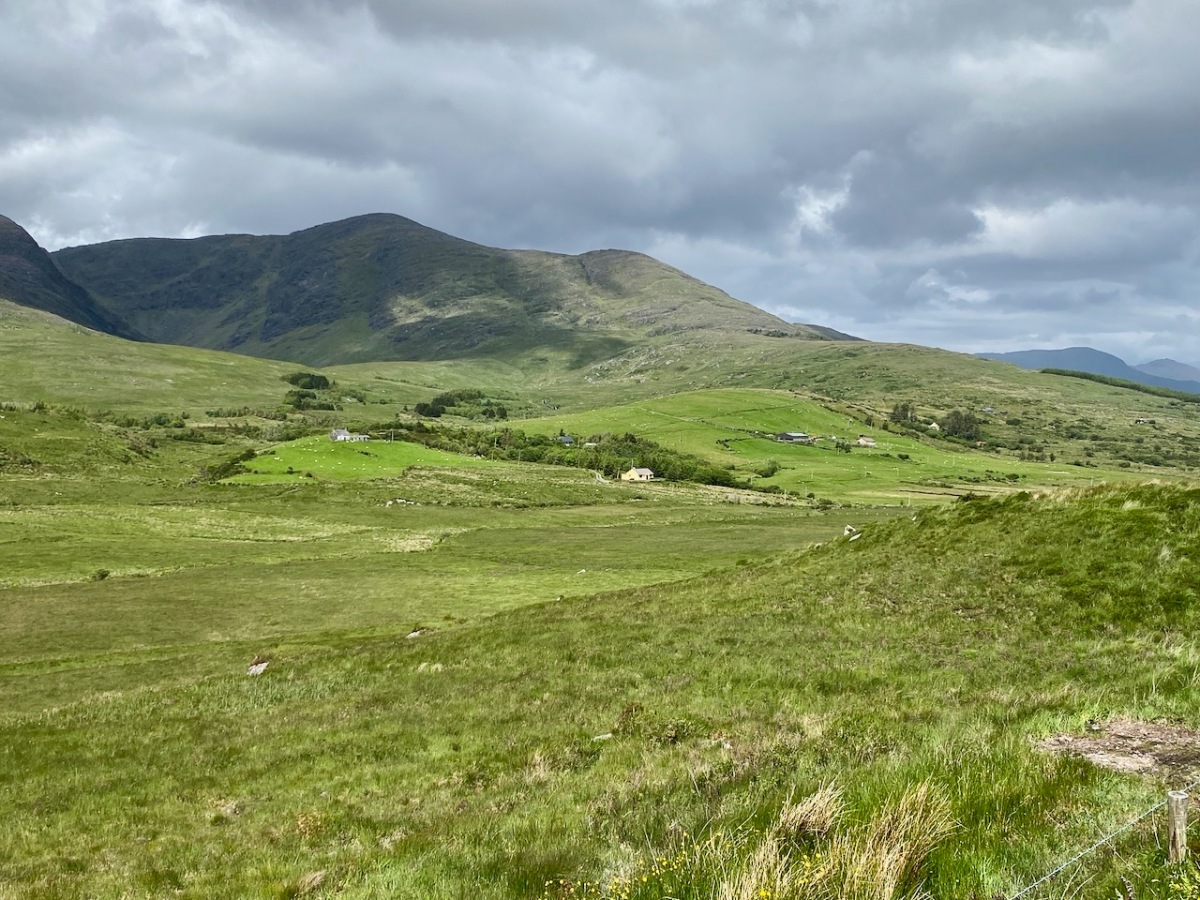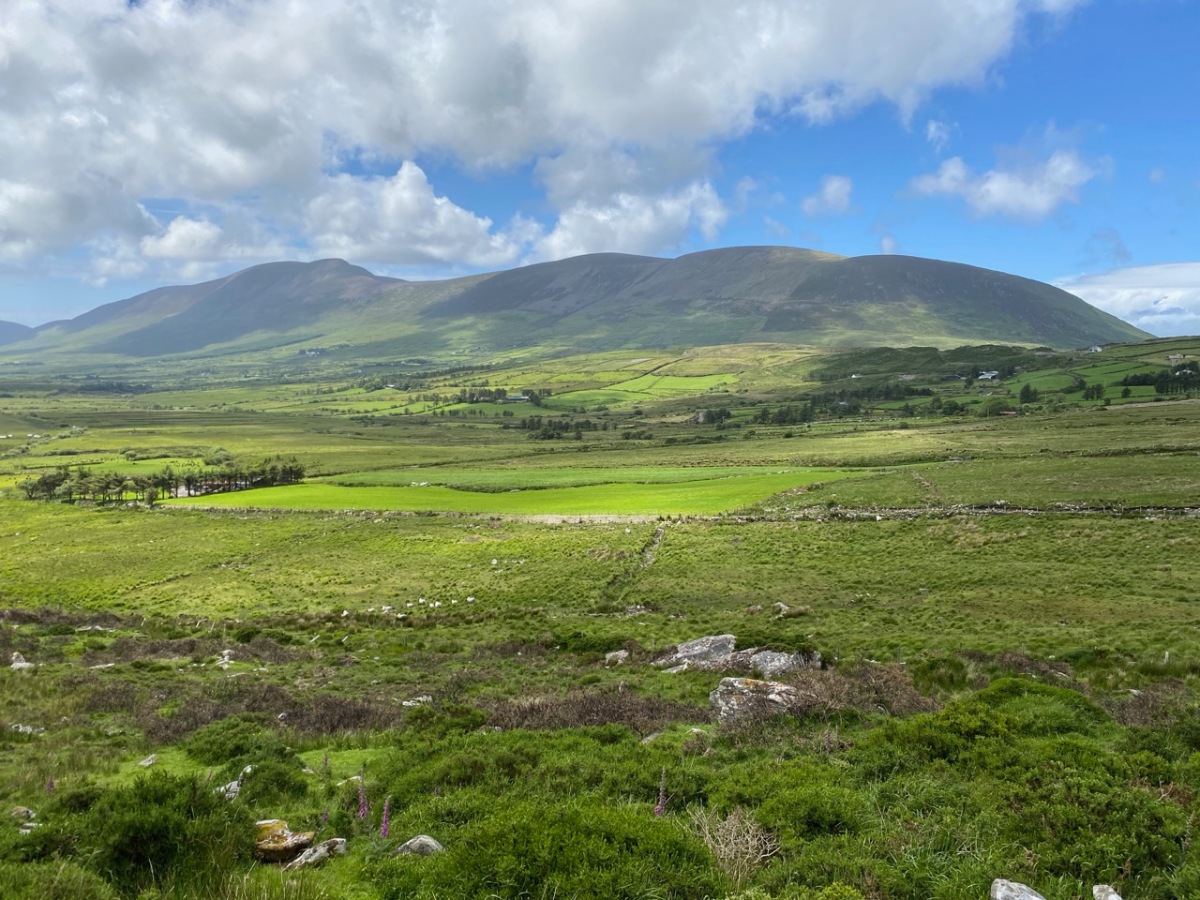
We spent a couple of days in Kerry a week before midsummer, and gave you some account of our discoveries on Church Island, Lough Currane, and up in the hills at Caherlehillan – both memorable Early Christian sites. Our adventures did not end there: we managed to take in, also, some other ancient treasures, a couple of Kerry characters, and some stunning scenery – hard to match – as we travelled back to West Cork along the Ring of Kerry road (above).

Firstly, here are Charlie Chaplin and Michael Collins (above), both familiar figures in Waterville. The Hollywood star spent his summer holidays in the coastal town for many years with his family and is commemorated by a bronze statue, while Michael can be found on most days in this much photographed location, always ready to entertain with Kerry polkas and slides on his accordion.

Here’s a much earlier Kerry musician: he’s known as ‘The Fiddler’, and is an unusual medieval representation of an instrumentalist found in the romanesque ruin on Church Island, Lough Currane. I was pleased to find this photograph in the Royal Society of Antiquaries of Ireland Notes from 1908 by P J Lynch as it shows the carving as it was found by the OPW when they took over the site. Now the original, which had suffered accelerated weathering, is kept protected in a museum while a well-worn replica is in place on the site. I believe the carving is a good representation of a medieval bowed lyre, an instrument with six strings which survives today in some cultures, although Lynch gave the following commentary:
. . . The interest in this stone centres in the musical instrument. The examples of ancient carving in Ireland representing stringed instruments are few, and confined to harpers. The photograph illustrates this instrument very clearly. It is the ancient cruit or fidil, said to be the parent of the violin. There are six strings indicated by sunken lines in the stone. The figure appears to wear a kind of tight-fitting tunic. Dr O’Sullivan states that the word fidil being a teutonic version of the original name vièle, it may be concluded that the original instrument was introduced through the Anglo-Saxons, and not through the Normans. He adds that up to the eleventh century it consisted of a conical body, and after that it became oval. If this be a portion of the twelfth-century instrument, the older pattern must have survived. The Kerry people were probably as unwilling to change in those days as they are at present . . .
P J Lynch – Some notes on church island – RSAI 1908


Our trip out to Church Island (above) was accompanied by moody weather, but we were fortunate with other expeditions which included the discovery of ancient sites in the townland of Srugreana (Srúbh Gréine in Irish, which is translated variously as sunny stream, gravelly stream or – my favourite – snout of the sun: Kerry certainly offers some tricky pronunciations for those unfamiliar with the area, or the language!).

This extract from the 6″ OS map, dating from the mid-1800s, shows one area we explored on our Kerry day. It throws up some enigmas: Killinane Church (the church of Saint Lonan or Lonáin) is often referred to as Srugreana Abbey, but this is a separate site indicated further to the north-west on the early plan.





The church site at Srugreana is remarkable in many ways. A 2012 survey commissioned by Kerry County Council Heritage Office found there are at least 1,290 unhewn, uninscribed gravemarkers around the medieval church, and a significant number of ‘house type’ tombs, some of which are ‘two-storey’, like the one above. The concentration of graves – many of which cannot be dated – suggests how populous this now remote area was at one time.


The main purpose of our visit to Srugreana was to search out a holy well dedicated to Saint Gobnait (above). The expedition was led by Amanda, who runs the Holy Wells of Cork and Kerry website. You need to read her comprehensive article on this particular saint here. Interestingly, while we were visiting the well we met the new owner of the land on which it sits. She had no idea that there was a holy well here, and also was unaware of its apparently recent renovation! Note the crosses carved on the stones by visiting pilgrims, above.

From the above accounts, and our two previous posts, you can tell that we had a most productive time exploring just one small area in the ‘Kingdom’ of Kerry. I am rounding off this entry with some more photographs of our journey back along the coast. The weather gave of its best for this county which is our neighbour, and we will continue to explore it and look for more archaeological gems. Keep reading!






What a fabulous resource this journal is for those of us, far away, who are thus able to make the journey vicariously with you.
LikeLiked by 1 person
Thank you, Walter. We hope you continue to enjoy travelling with us!
LikeLike
I just love that photo of Charlie and Michael! A great encounter to start off a day of exploring. The old graveyard by St Gobnait’s well was full of very intriguing tombs and I was thrilled to find the well.
LikeLiked by 1 person
It was a good collection of things and places to explore, Amanda. Thank you for asking us along!
LikeLike
Lovely to see the well still being used and respected. I’ve never seen those ‘house type tombs’ before! Have you come across them in other places? Any idea what age they are? I love the photo with Michael Collins. Interested to read from P J Lynch’s extract that the ‘fidil’ was thought to be introduced by the Anglo-Saxons – I’d have thought it was in Ireland long before that? I’m trying to remember if it is mentioned in any of the old legends. What an idyllic place. And that water!! 🙂
LikeLiked by 1 person
Jo, I have searched for more information on those ‘house type’ tombs. We have seen some which are similar in some ways in other places. I would like to know their age. Kerry commissioned a survey of the graveyard in 2012, but it is completely silent on any dating.
LikeLiked by 1 person
Oh that’s frustrating! They look old but that doesn’t mean anything I guess!
LikeLiked by 1 person
The ‘house’ tombs: I would guess 18th century, but perhaps early nineteenth. And they would span a fair time. The fiddle – here is a reasonably measured review of its history – https://celticlifeintl.com/history-of-the-celtic-fiddle/ But no-one knows for sure, of course!
LikeLiked by 1 person
Thank you! So Anglo-Saxon is about right then! I’d like to feel that there’s an alternative universe where Ireland invented the fiddle because they’ve made it their own! Re. the house tombs, that’s interesting – goes to show how deceptively ancient things can look – but you only have to look at houses/bothies of a similar date.
LikeLiked by 1 person
Fascinating account of lesser known Kerry sites. Thank you for sharing.
LikeLiked by 1 person
Hello Robert and Finola My name is Michael Gleeson and I subscribe and love your newsletter. I bought a home on the coast in Reenagrena near Glandore a few years and have been so enjoying my time there particularly the beauty of West Cork and learning more about the local history and culture. I’m 62, became a dual citizen, and since my youth in England have always wanted to be back in Ireland. I look forward to your newsletter every week and have learned so much more than I would otherwise. Even during the last year I have been fortunate to still be able to get back for four two week stays. (Citizenship, quarantining at home, vaccinated and all the tests have made that possible). My partner Jane and I are heading back August 5th to the 14th ( she has not joined me there yet). This email is to thank you for your wonderful newsletters but also to extend an invite over for tea if you are interested and would feel comfortable with doing that. I am located at the mouth of the harbor and in addition to a magical view, am apparently surrounded by ancient ring circles, cillin cemetery, a cool promitory, and what looks like a small famine village ( which based on my little research may be an old coastguard station from the late 1800’s. Let me know if you would be interested in meeting out there either this trip or in the future. It would nice to meet you both and I’d love to learn more about the area. Someday I hope to immerse myself more in the history and beauty of the area. All the nest. Regard, Michael Gleeson
Michael J Gleeson President Gleeson Construction Inc. 189 E. Washington Street Chagrin Falls, Ohio 44022
– PH: (44)247-8775×110 FAX: (440)247-3874 CELL: (440)821-0738
– EMAIL: mjgleeson@gleesonconstruction.com
– WEB: http://www.gleesonconstruction.com
– “A Culture of Quality”
________________________________
LikeLiked by 1 person
Michael, we are replying via email.
LikeLike